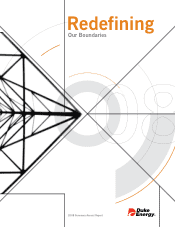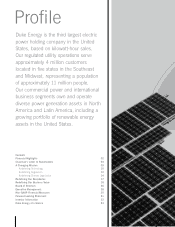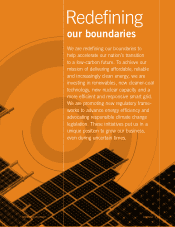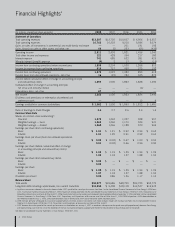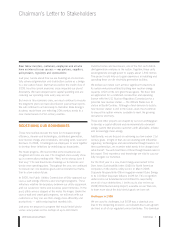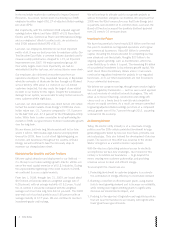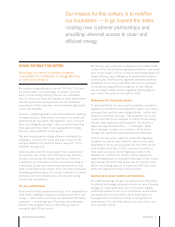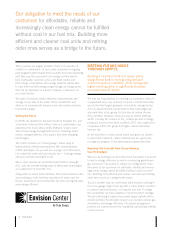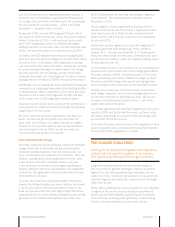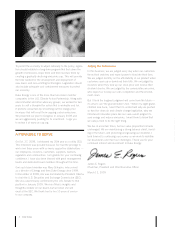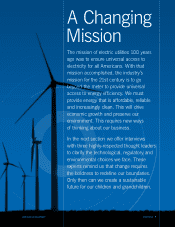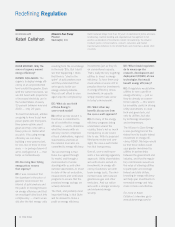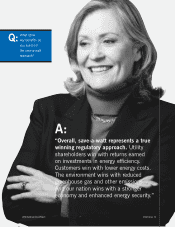Duke Energy 2008 Annual Report Download - page 5
Download and view the complete annual report
Please find page 5 of the 2008 Duke Energy annual report below. You can navigate through the pages in the report by either clicking on the pages listed below, or by using the keyword search tool below to find specific information within the annual report.
2008 Summary Annual Report Duke Energy 3
Chairman’s Letter to Stakeholders
Dear fellow investors, customers, employees and all who
have an interest in our success — our partners, suppliers,
policymakers, regulators and communities:
Last year, I wrote about how we are building an environmen-
tally advanced generation and distribution system as a bridge
to a low-carbon future. But that was before the credit crisis of
2008. Has the current economic crisis impacted our plans?
Absolutely. We have delayed some capital spending and are
reducing our operating costs every way we can.
But even in this economic crisis, we must continue to execute
the long-term plans we have described in past annual reports.
We will continue to act decisively to transition Duke Energy’s
business model from one reflecting 20th century needs to a
new model based on 21st century realities.
REDEFINING OUR BOUNDARIES
These new realities include the need for increased energy
efficiency, cleaner coal technologies, distributed generation,
new nuclear energy and renewables, including wind, solar and
biomass. In 2008, I challenged our employees to work together
to develop these initiatives by redefining our boundaries.
We made progress. We learned that some boundaries are
imagined and some are real. The imagined ones usually show
up in conversations ending with: “Well, we’ve always done it
that way.” The real boundaries challenge us to innovate and
devise new operating plans. Throughout the year, we continued
to execute our core business goals and accelerated our transi-
tion to a low-carbon future.
In 2008, the Public Utilities Commission of Ohio approved our
save-a-watt energy efficiency and smart grid programs. These
initiatives redefine the boundary between our utility equipment
and our customers’ home and business power networks. In the
past, utility service stopped at the meter. No longer. Under the
save-a-watt and smart grid programs, we will work with our
customers so they can use their energy more efficiently and
productively — while reducing their monthly bills.
Last year, we proposed a program that would install photo-
voltaic solar panels on the rooftops of up to 400 North
Carolina homes and businesses, one of the first such distrib-
uted generation ventures in the nation. Together, these units
would generate enough power to supply about 1,300 homes.
This project could help us to gain experience in installing and
operating these on-site electricity generation facilities.
We believe our nation can’t achieve significant reductions in
its carbon emissions without building new nuclear energy
capacity, which emits zero greenhouse gases. We have filed
an application for a combined construction and operating
license with the U.S. Nuclear Regulatory Commission for a
potential new nuclear station — the William States Lee III
station in South Carolina. Although a final decision to build a
new nuclear station is still in the future, work must continue
to ensure this option remains available to meet the growing
demand for electricity.
These and other projects are shaped by our over-arching goal:
to develop a capital-efficient and environmentally advanced
energy system that provides customers with affordable, reliable
and increasingly clean energy.
Additionally, we are focused on achieving our low-carbon 21st
century goals. In light of that, we are working with influential
regulatory, technological and environmental thought leaders. In
these partnerships, we examine what needs to be changed and
what doesn’t. You will meet three of these thought leaders later in
this report. Their experience and knowledge are vital to success-
fully navigate our transition.
For the third year in a row, Duke Energy was named to the
Dow Jones Sustainability Index (DJSI) for North American
companies in the electric utility sector. In March 2009,
Corporate Responsibility Officer magazine named Duke Energy
to its 100 Best Corporate Citizens 2009 list. This recognition
underscores our fundamental commitment to responsibly
serve all of our stakeholders. I invite you to also review our
2008|2009 Sustainability Report, available on our Web site,
to learn more about the bold stretch goals we have set.
Challenges in 2008
We are used to challenges, but 2008 was a standout year.
Due to the deepening recession, our kilowatt-hour sales growth
declined in all of our regulated service territories. The downturn

